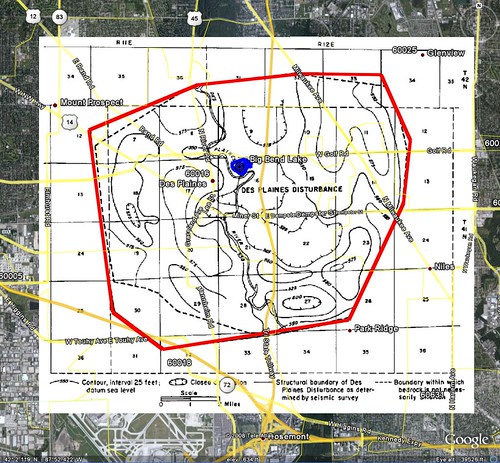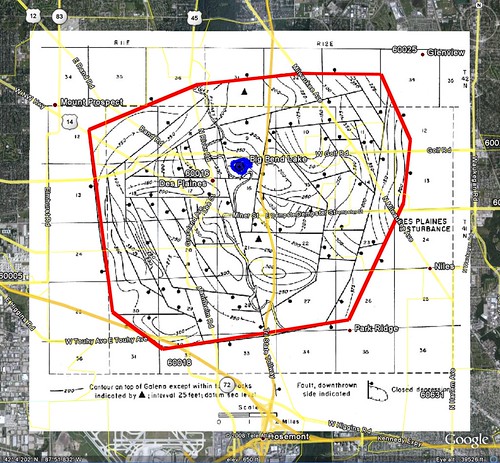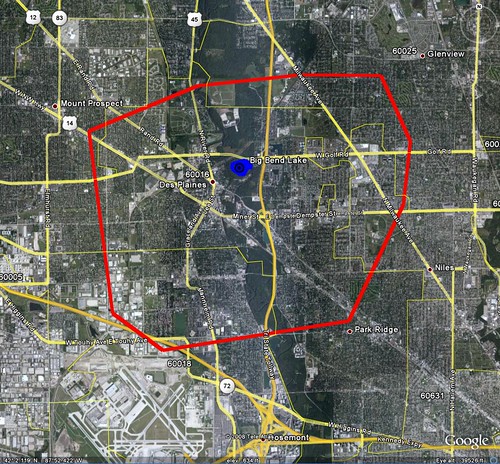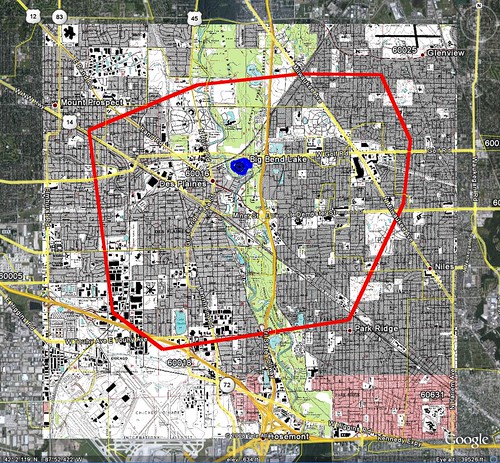1) Please take waypoints to estimate the width and length of the
impact zone (the lake).
2) Using the info above calculate the circumference of the lake
and send me an email with the info. (Thanks! Unk)
3) Post a picture of you at the lake.
This lake represents the probable impact point of a large
ancient (280 million years ago) meteor crater 5.5 miles wide x 4.5
miles in length.

Big Bend Lake An impact crater forms when an asteroid or
comet strikes another body such as an asteroid, planet, or moon at
high speed. All of the surfaces of the inner planets and their
moons (Mercury, Venus, Earth, and Mars) have been heavily
bombarded. Because the Earth is so active geologically, most traces
of impact craters have been erased by erosion and tectonic
activity. Nevertheless, over one hundred seventy impact craters
have been identified on Earth. Several more are found each
year.
Portions of Des Plaines are underlain by the "Des Plaines
Disturbance", an area in which the layers of sedimentary rock are
highly abnormal. The bedrock was highly fractured by the impact,
with large blocks of sediment upended. Most of the crater was
eventually filled by glacial activity.

Elevation of the Bedrock Surface in The Des Plaines
Disturbance
The disturbance is a roughly circular area of approximately 25
square miles that is intensely faulted. Some of these faults may
have as much as 600 feet of vertical movement.

Structure in The Des Plaines Disturbance
The roughly circular site exhibits complex faulting and shock
features such as percussion fractures and strain lamellae, as well
as a few shatter cones. The center of the crater lies under Big
Bend Lake on the Des Plaines River.
Seismic reflection data suggest that there are numerous other
faults within the bedrock of Cook County. None of these faults are
currently active, and the seismic risk to the Chicago area from
them is minimal.

Aerial photo of The Des Plaines Disturbance
The impacting body generally melts and mixes with the rocks at
the impact site. Sometimes the impact site reveals an abundance of
siderophile elements such as iridium, osmium, platinum, and
palladium. Other tell-tale signs of an impact are products of shock
metamorphism such as shatter cones, planar features in quartz and
feldspar, diaplectic glass, and a high-pressure form of quartz
called stishovite. Stishovite has never been found anywhere else
but impact sites.
Impact craters may be simple or complex. Simple craters are
relatively small with a smooth bowl shape, and exhibit a
depth-to-diameter ratio of about one-to-six. Meteor Crater in
Arizona is a good example of a simple impact crater. This crater is
about 1,200 meters in diameter and 170 meters deep. The crater rim
rises nearly 80 meters about the surrounding plain. The crater was
formed between 20,000 and 50,000 years ago by the impact of an iron
meteorite weighing over over 60,000 tons.
Complex craters are larger in diameter but shallower in depth.
Complex craters usually possess a depth-to-diameter ratio of
between one-to-ten and one-to-twenty. Gravity collapses the crater
walls downward and inward. A central peak may form when the crater
floor rebounds from the impact. To become complex, a crater must
have a large enough diameter. On Earth the transition diameter lies
between two and four kilometers.

Topo Map of The Des Plaines Disturbance